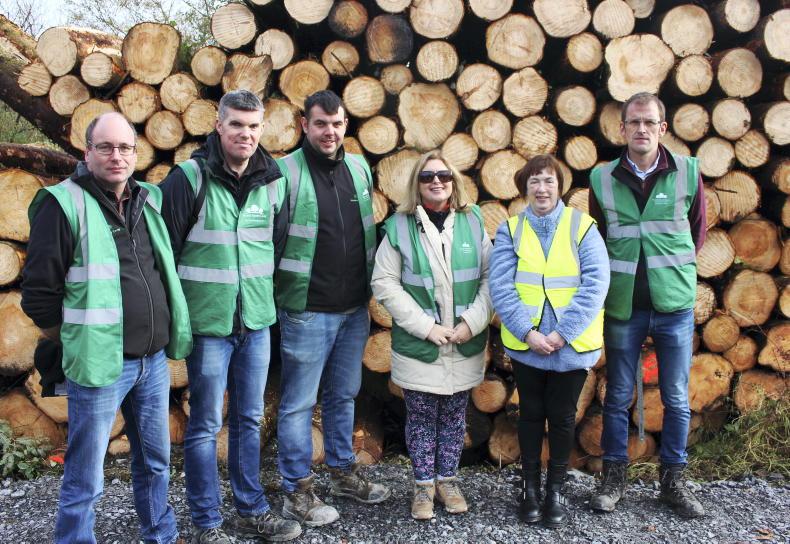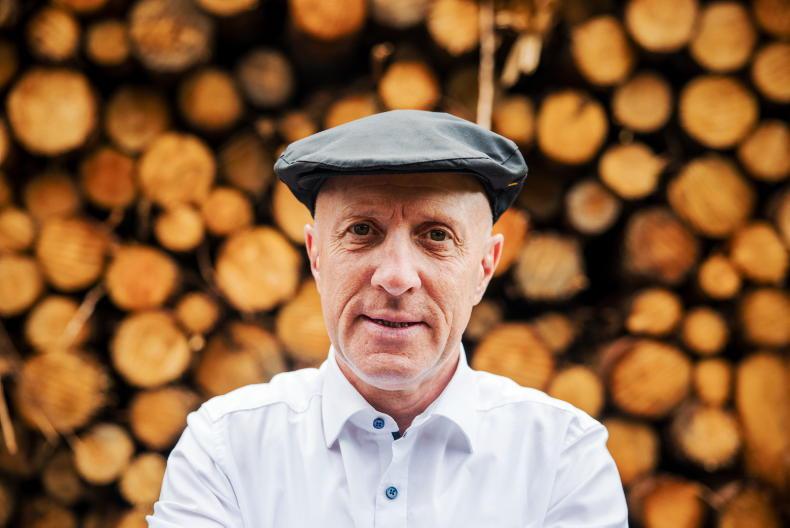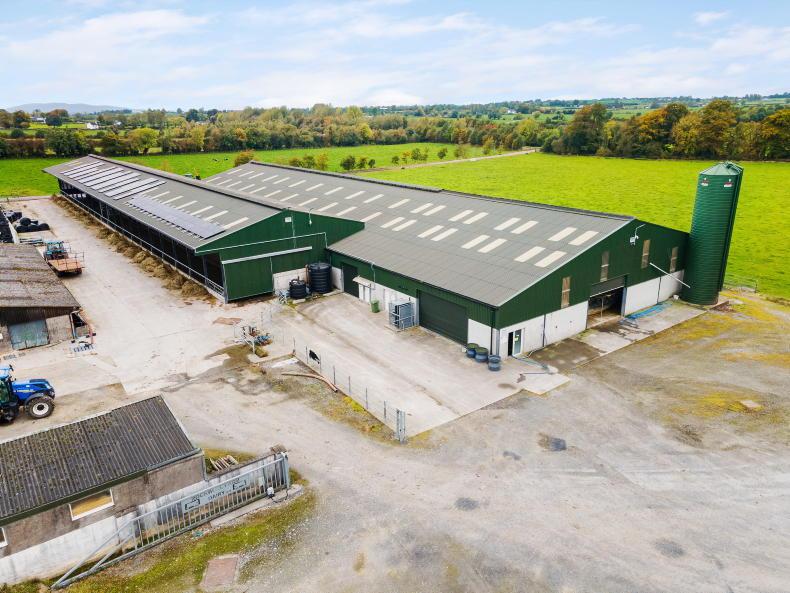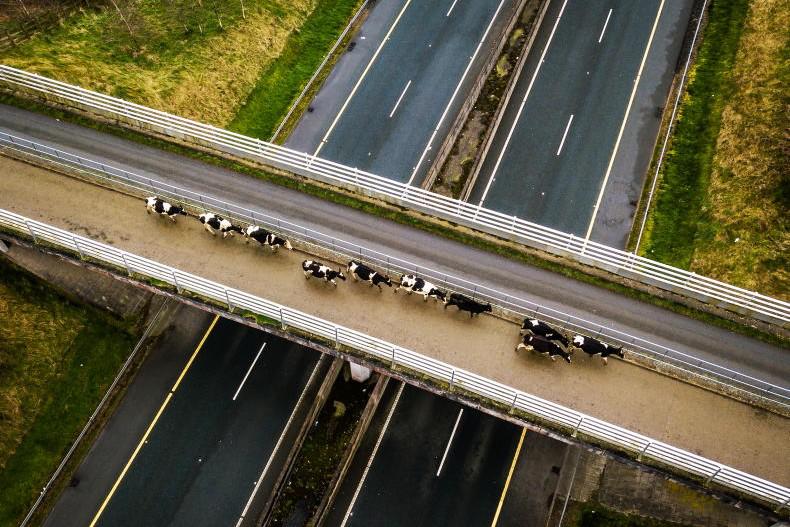“Whose woods these are I think I know.
His house is in the village though.”
– From Stopping by Woods on a Snowy Evening by Robert Frost
In Stopping by Woods on a Snowy Evening, Robert Frost doesn’t enter the wood but is reassured that the owner lives in the nearby New Hampshire village.
Frost, a poet and farmer, values access to the woods and forests as depicted in a number of poems, not least The Road Not Taken as he grapples with life’s decisions on which direction he should take at the point where two forest roads diverge.
Irish forestry is now faced with Frost’s metaphorical dilemma on which road to travel – or not travel.
For most of the last century, there was just one road as the State planted 95% of the national afforestation programme and provided virtually all the timber to Irish timber processors.
Since the establishment of Coillte in 1989, the State has relinquished its hold on afforestation. From the late 1980s to 2017, the private sector – mainly farmers – took over the afforestation programme, achieving planting programmes averaging 13,218ha during the 10-year period from 1994 to 2013.
Farming groups often talk about a return to those halcyon days when non-farmer investors received much smaller State supports than farmers.
But close examination of this period shows diverse investment in afforestation including Coillte, which averaged 2,431ha.
The resultant average breakdown of the total average annual 15,400ha afforestation programme was approximately 68% farmer, 16% non-farmers and 16% Coillte.
The withdrawal of EU and State supports for Coillte and the “levelling up” of funding for non-farmers changed the dynamic of forest investment.
Unsuccessful
Coillte withdrew from the market, apart from an unsuccessful farm partnership scheme, while farmers regained pole position until 2017 when they withdrew from the afforestation programme and now plant only 360ha annually.
Successive governments since the 1980s have indicated that farmer afforestation is the preferred option in achieving a viable forestry and forest products sector.
This support is now not as clear as neither Minister McConalogue nor Minister of State Hackett have objected to the establishment of Coillte’s new State-private venture despite calls from the IFA, the Irish Timber Council (ITC) and other rural-based organisations.
Minister for the Environment, Climate and Communications Eamon Ryan favours EU State aid to allow Coillte to purchase land for afforestation.
The current Climate Action Plan doesn’t outline the specific role – or planting targets – for farmers in increasing Ireland’s “annual afforestation rates from approximately 2,000ha per annum in 2021 and 2022 to 8,000ha”.
While the plan is clear on the major role of afforestation as a land use in mitigating climate change, it mentions only Coillte directly as part of the solution.
One of the plan’s actions is to “develop, assess, and adopt as appropriate the new forestry programme and Coillte’s strategic vision”, which amounts to 3,500ha per annum based on 100,000ha of new forests by 2050 comprising 50,000ha of native woodland, accessible by the public, and 50,000ha of commercial forests.
The strategic vision was sold to stakeholders and Government last April on the premise that it would help Ireland meet climate targets, which was one of the reasons it received a cautious welcome.
The Irish Strategic Forestry Fund – established between Coillte and Gresham House – has since been heavily criticised, because it raises fundamental questions about new and existing forest ownership, institutional investment and related issues such as forestry land prices and forest access.
Forest ownership is the unifying theme among many critics
The fund departs from the announcement last April, which stressed Coillte’s desire to afforest land to help Ireland achieve its climate change goals. It now includes purchasing existing forests which will do nothing for climate change mitigation.
Forest ownership is the unifying theme among many critics. Coillte should have been aware of this.
When the Government advocated the sale of Coillte’s harvesting rights in 2012, there was major public opposition.
Following a massive protest in Avondale Forest Park in 2013, the Government withdrew its privatisation plan.
While the sale of Coillte’s forests does not arise this time, the purchase of forests or land suitable for forestry, raises question about who owns the future forest estate, as well as issues such as land price inflation, carbon trading, the role of farm forestry and the return of Coillte as the dominant timber supplier.
The ITC, which represents Irish sawmillers, has outlined its “grave concerns” with the Coillte-Gresham House deal. “The council is strongly opposed to creating conditions where only Coillte, individually or through corporate alliances, can, directly or indirectly, be the primary purchaser of existing mature or semi-mature private forestry,” John Murray, ITC chair, told the joint committee on agriculture, food and the marine on 22 February.

John Murray.
“Given Coillte’s dominant position in the Irish log supply market, it is totally unacceptable for it to increase this position through the purchase of existing forestry, which is tantamount to taking competition out of the market,” he added.
One way or another, the forestry landscape is about to change.
In the absence of farmer afforestation, Coillte and private investors will control future forestry programmes.
This is a role not discouraged by Government and blaming Coillte misses the point.
The company is fulfilling its commercial mandate by maximising dividends for its two shareholders – the Minister for Finance and the Minister for Agriculture – which is why it was established.
With the proactive presence of farmers, Ireland could get back to a healthy farmer and investor forestry mix.
Farmers could again dominate the afforestation programme, just as they did from 1989 to 2017 until a dysfunctional licensing system, excessive bureaucracy, reduced premium periods for farmers, and the ravages of ash dieback all ensured their rapid exit.
In the meantime, Coillte’s role dominates discussions on forestry. In a vibrant farm forestry sector it would be no more than a minor distraction.
That it has morphed into a major diversion outlines the need for a real debate on the future of Irish forestry.
The IFA, Irish Forest Industries, ITC, nurseries, foresters, forestry companies and respected organisations such as the Society of Irish Foresters (SIF) and Irish Timber Growers Association (ITGA) have called for the establishment of an independent Forestry Development Agency (FDA) to represent the forestry and forest products sector.
“An FDA-type organisation would address the forest sector in its totality and would drive the sector, such as exists in other natural resource sectors,” said Pat O’Sullivan, SIF.
“It is inconceivable that forestry is the only natural resource without such a body.”
Deer study to focus on native biodiversity
The School of Biology and Environmental Science, UCD, is conducting a study “measuring the impact of overabundant deer on native biodiversity”.
The project will shed light on how deer in Ireland are affecting biodiversity and help define a management plan on a national level and open up possibilities for wider research on this topic.
The School of Biology and Environmental Science, UCD, is seeking additional forest sites for its study. Sites may be fenced (no access for deer for at least two years) or unfenced. Readers interested in assisting this project should email Colin Brock (colin.brock@ucd.ie) who will provide further information on this important study.
Woodland valuation webinar
Valuation of forests and woodland is a complex issue as it depends on species, crop quality, age, location and access.
A panel of experts will provide their findings in a free webinar scheduled for 15 March between 10am and 11am. They include James Adamson, Scotland; Andrew Bronwin, Wales; Mike Tustin, England and Tom McDonald, Ireland. Click here to book your place at the webinar.
“Whose woods these are I think I know.
His house is in the village though.”
– From Stopping by Woods on a Snowy Evening by Robert Frost
In Stopping by Woods on a Snowy Evening, Robert Frost doesn’t enter the wood but is reassured that the owner lives in the nearby New Hampshire village.
Frost, a poet and farmer, values access to the woods and forests as depicted in a number of poems, not least The Road Not Taken as he grapples with life’s decisions on which direction he should take at the point where two forest roads diverge.
Irish forestry is now faced with Frost’s metaphorical dilemma on which road to travel – or not travel.
For most of the last century, there was just one road as the State planted 95% of the national afforestation programme and provided virtually all the timber to Irish timber processors.
Since the establishment of Coillte in 1989, the State has relinquished its hold on afforestation. From the late 1980s to 2017, the private sector – mainly farmers – took over the afforestation programme, achieving planting programmes averaging 13,218ha during the 10-year period from 1994 to 2013.
Farming groups often talk about a return to those halcyon days when non-farmer investors received much smaller State supports than farmers.
But close examination of this period shows diverse investment in afforestation including Coillte, which averaged 2,431ha.
The resultant average breakdown of the total average annual 15,400ha afforestation programme was approximately 68% farmer, 16% non-farmers and 16% Coillte.
The withdrawal of EU and State supports for Coillte and the “levelling up” of funding for non-farmers changed the dynamic of forest investment.
Unsuccessful
Coillte withdrew from the market, apart from an unsuccessful farm partnership scheme, while farmers regained pole position until 2017 when they withdrew from the afforestation programme and now plant only 360ha annually.
Successive governments since the 1980s have indicated that farmer afforestation is the preferred option in achieving a viable forestry and forest products sector.
This support is now not as clear as neither Minister McConalogue nor Minister of State Hackett have objected to the establishment of Coillte’s new State-private venture despite calls from the IFA, the Irish Timber Council (ITC) and other rural-based organisations.
Minister for the Environment, Climate and Communications Eamon Ryan favours EU State aid to allow Coillte to purchase land for afforestation.
The current Climate Action Plan doesn’t outline the specific role – or planting targets – for farmers in increasing Ireland’s “annual afforestation rates from approximately 2,000ha per annum in 2021 and 2022 to 8,000ha”.
While the plan is clear on the major role of afforestation as a land use in mitigating climate change, it mentions only Coillte directly as part of the solution.
One of the plan’s actions is to “develop, assess, and adopt as appropriate the new forestry programme and Coillte’s strategic vision”, which amounts to 3,500ha per annum based on 100,000ha of new forests by 2050 comprising 50,000ha of native woodland, accessible by the public, and 50,000ha of commercial forests.
The strategic vision was sold to stakeholders and Government last April on the premise that it would help Ireland meet climate targets, which was one of the reasons it received a cautious welcome.
The Irish Strategic Forestry Fund – established between Coillte and Gresham House – has since been heavily criticised, because it raises fundamental questions about new and existing forest ownership, institutional investment and related issues such as forestry land prices and forest access.
Forest ownership is the unifying theme among many critics
The fund departs from the announcement last April, which stressed Coillte’s desire to afforest land to help Ireland achieve its climate change goals. It now includes purchasing existing forests which will do nothing for climate change mitigation.
Forest ownership is the unifying theme among many critics. Coillte should have been aware of this.
When the Government advocated the sale of Coillte’s harvesting rights in 2012, there was major public opposition.
Following a massive protest in Avondale Forest Park in 2013, the Government withdrew its privatisation plan.
While the sale of Coillte’s forests does not arise this time, the purchase of forests or land suitable for forestry, raises question about who owns the future forest estate, as well as issues such as land price inflation, carbon trading, the role of farm forestry and the return of Coillte as the dominant timber supplier.
The ITC, which represents Irish sawmillers, has outlined its “grave concerns” with the Coillte-Gresham House deal. “The council is strongly opposed to creating conditions where only Coillte, individually or through corporate alliances, can, directly or indirectly, be the primary purchaser of existing mature or semi-mature private forestry,” John Murray, ITC chair, told the joint committee on agriculture, food and the marine on 22 February.

John Murray.
“Given Coillte’s dominant position in the Irish log supply market, it is totally unacceptable for it to increase this position through the purchase of existing forestry, which is tantamount to taking competition out of the market,” he added.
One way or another, the forestry landscape is about to change.
In the absence of farmer afforestation, Coillte and private investors will control future forestry programmes.
This is a role not discouraged by Government and blaming Coillte misses the point.
The company is fulfilling its commercial mandate by maximising dividends for its two shareholders – the Minister for Finance and the Minister for Agriculture – which is why it was established.
With the proactive presence of farmers, Ireland could get back to a healthy farmer and investor forestry mix.
Farmers could again dominate the afforestation programme, just as they did from 1989 to 2017 until a dysfunctional licensing system, excessive bureaucracy, reduced premium periods for farmers, and the ravages of ash dieback all ensured their rapid exit.
In the meantime, Coillte’s role dominates discussions on forestry. In a vibrant farm forestry sector it would be no more than a minor distraction.
That it has morphed into a major diversion outlines the need for a real debate on the future of Irish forestry.
The IFA, Irish Forest Industries, ITC, nurseries, foresters, forestry companies and respected organisations such as the Society of Irish Foresters (SIF) and Irish Timber Growers Association (ITGA) have called for the establishment of an independent Forestry Development Agency (FDA) to represent the forestry and forest products sector.
“An FDA-type organisation would address the forest sector in its totality and would drive the sector, such as exists in other natural resource sectors,” said Pat O’Sullivan, SIF.
“It is inconceivable that forestry is the only natural resource without such a body.”
Deer study to focus on native biodiversity
The School of Biology and Environmental Science, UCD, is conducting a study “measuring the impact of overabundant deer on native biodiversity”.
The project will shed light on how deer in Ireland are affecting biodiversity and help define a management plan on a national level and open up possibilities for wider research on this topic.
The School of Biology and Environmental Science, UCD, is seeking additional forest sites for its study. Sites may be fenced (no access for deer for at least two years) or unfenced. Readers interested in assisting this project should email Colin Brock (colin.brock@ucd.ie) who will provide further information on this important study.
Woodland valuation webinar
Valuation of forests and woodland is a complex issue as it depends on species, crop quality, age, location and access.
A panel of experts will provide their findings in a free webinar scheduled for 15 March between 10am and 11am. They include James Adamson, Scotland; Andrew Bronwin, Wales; Mike Tustin, England and Tom McDonald, Ireland. Click here to book your place at the webinar.










SHARING OPTIONS